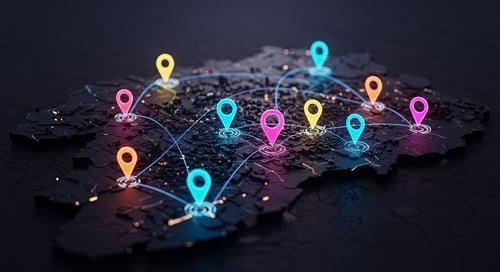Modern Customer Journeys: Mapping Touchpoints in a Digital-First World

Summary: Discover how AI transforms customer journey mapping across digital touchpoints. Learn practical steps and real-world examples to boost engagement and loyalty.
The customer journey is no longer what it used to be. Gone are the days of a straightforward path from awareness to purchase. Today, customers interact with brands across multiple channels like social media, websites, emails, and more, expecting a seamless and personalized experience at every touchpoint. For digital marketers, understanding and optimizing this complex journey is crucial.

The customer journey isn’t just a funnel anymore. It’s more like a sprawling city map with endless routes, shortcuts, and detours. Every interaction matters. Every touchpoint can be a make-or-break moment. That’s why today’s marketers need more than intuition. They need clear maps and smart tools that keep pace with customer expectations.
This isn’t theory. It’s the real deal, in real time. Customers expect seamless experiences wherever they connect with your brand, whether that’s on social media, your website, or a quick chat.
And AI? It’s the secret weapon turning raw data into meaningful journeys.
Understanding the Modern Customer Journey
Once upon a time, the customer journey was neat and predictable: Awareness led to Consideration, then Purchase, followed by Retention and maybe, if things went really well, Advocacy.
But that old funnel doesn’t hold up in today’s digital reality. Now, customers hop between channels, devices, and stages with very little warning. Someone might spot your product on Instagram, dive into your site for details, check out third-party reviews, and make a purchase through an app, all in the span of a few hours.
This shift from linear to omnichannel means businesses need to think less like choreographers and more like responsive hosts. Every interaction, whether it’s a social media post, a quick scroll through your mobile site, a search result, or a product review, is now a digital touchpoint. These moments add up. They either pull customers closer or push them away.
Social media platforms like Facebook, Instagram, and LinkedIn serve a similar purpose. Email marketing, like newsletters, offers, and personalized campaigns, plays another role. Then there’s search: both the organic results and paid placements that show up in a potential customer’s moment of need. Your website and mobile app? Those are your digital storefronts. Even reviews and online forums matter more than you think. They all help customers decide whether you’re worth their time.
Now here’s where it gets smart: AI is changing how we understand these journeys. AI isn’t just analyzing customer behavior; it’s mapping it. Processing massive amounts of data helps pinpoint which touchpoints are driving the most conversions. It also unlocks real-time personalization. Whether it’s product recommendations, messaging, or targeted content, AI helps you meet each customer where they are, with exactly what they need. Predictive analytics even lets you anticipate future behavior based on past actions, meaning you can act before your customer even asks.
If you’re mapping your own customer journey, start with your personas. Get to know your audience: their needs, behaviors, and pain points. WSI’s Buyer Persona Template can serve as a starting point if you need one. Then, look at your current journey: what are the online and offline touchpoints people use to interact with your brand? What are they trying to do at each stage? Where are they dropping off?
Next, dive into your data. See where people are engaging most, and where they’re losing interest. Bring in AI tools to sharpen the edges: chatbots for first-touch engagement, CRM systems to track ongoing conversations, AI-based product suggestions, and sentiment analysis after purchase to see how they really feel.
And don’t stop there. Test. Refine. Then test again. Try A/B testing across different touchpoints to figure out what clicks and what doesn’t. Because in this new, non-linear customer journey, the brands that thrive are the ones that stay curious, stay flexible, and show up at the right time with the right message.
What Does This Look Like in Practice? Scenario Walkthrough: Local Dental Clinic vs. Regional Retailer
Let’s zoom in on two very different businesses: a local dental clinic and a regional retailer, and see how their customer journeys play out in this digital-first world. We’ll also highlight one AI tool in action for each stage.
Local Dental Clinic: Human Meets High Tech
Here’s what a modern customer journey could look like for a local dental clinic:
Awareness (Chatbots)
Someone searches “best dental cleaning near me.” Your AI-powered chatbot on the website greets the visitor:
“Hi! Need help scheduling an appointment or want to know about our services?“
It answers FAQs instantly and can even book an appointment without needing to wait on hold.
Consideration (CRM)
After browsing, the visitor leaves contact details to get a consultation. The CRM system tracks this lead, logging interactions and sending personalized follow-ups, like reminders for teeth whitening promotions or educational content on oral health.
Purchase (AI-Optimized Scheduling)
The patient books an appointment online with an AI-driven scheduling tool that optimizes calendar slots for both patient convenience and staff availability—no awkward back-and-forth.
Post-Purchase (Sentiment Analysis)
After the appointment, an automated survey powered by sentiment analysis goes out. It picks up on subtle feedback trends, alerting staff if any patients mention discomfort or delays so that issues can be addressed quickly.
Regional Retailer: Scale Meets Personalization
Here’s what a modern customer journey could look like for a regional retailer:
Awareness (AI-Powered Search & Social Monitoring)
A shopper scrolls Instagram and sees a tailored ad powered by AI analyzing their past browsing habits. AI also monitors social media chatter about your brand, flagging trending product interests to tweak ad focus.
Consideration (AI Chatbots & CRM)
The shopper visits your website and adds items to their cart. An AI chatbot pops up, answering questions about sizing and shipping. Meanwhile, your CRM tracks the browsing and cart abandonment data to trigger personalized emails with discount offers.
Purchase (Fraud Detection & Order Management)
At checkout, AI systems run fraud detection checks seamlessly to protect the shopper. Post-purchase, an AI-powered order management system updates the customer in real time about shipping status.
Post-Purchase (Predictive Analytics & Upselling)
Based on purchase history, AI predicts when the customer might be ready for replenishment or complementary products. Personalized emails with product recommendations are sent, aiming to convert one-time buyers into loyal customers.
AI Tools That Supercharge Every Touchpoint
Here is a comprehensive overview of AI tools that can significantly enhance and optimize every touchpoint of your customer journey, ensuring a seamless and personalized experience for your customers. These advanced technologies are designed to engage visitors, nurture leads, secure transactions, and analyze feedback, all while providing real-time insights and automation to streamline your marketing efforts.
- Awareness
- Consideration
- AI Tool Example: CRM Systems (Salesforce Einstein)
- What It Does: Tracks interactions, personalizes outreach, and nurtures leads.
- Purchase
- AI Tool Example: Fraud Detection Tools (Kount)
- What It Does: Protects transactions and ensures a secure checkout experience.
- Post-Purchase
- AI Tool Example: Sentiment Analysis (MonkeyLearn, IBM Watson)
- : Analyzes customer feedback to improve the experience.
From Static Diagrams to Real-Time Dynamic Maps
Remember when journey maps were just walls plastered with sticky notes? Yeah, that won’t cut it anymore. Customer journey maps today are alive, interactive, dynamic, and powered by real-time data.
With AI’s help, you’re not guessing how customers move between touchpoints. You’re watching it happen live, uncovering new insights, spotting pain points before they snowball, and continuously optimizing every step.
For instance, tools like UXPressia and Miro now offer AI features that automatically analyze customer data and update your journey maps—no more manual guesswork.
Why Real-Time Data Matters
Real-time data means you can personalize and pivot on the fly. You can catch trends as they develop and respond immediately.
Imagine a sudden spike in product returns flagged by AI-driven sentiment analysis. That’s your chance to fix a problem before it hurts your brand. Or a surge in social media questions about a new feature—AI chatbots can jump in to provide instant answers and guide customers to helpful content.
AI Makes Personalization Scale
Personalization used to be a luxury for small segments of customers. Now, AI lets you personalize at scale by tailoring offers, content, and support to millions without losing that personal touch.
This is where predictive analytics shines. AI finds patterns humans can’t see, predicting what your customers want before they know it themselves. The result? Marketing that feels personal, not pushy.
The upside? Customers tend to stay longer when their experience feels effortless and relevant. Instead of clunky, one-size-fits-all interactions, you’re offering conversations that actually make sense at the right time and in the right place. That kind of thoughtfulness builds loyalty fast.
It’s also a win for your team. With repetitive tasks offloaded to automation, they get to focus on the work that moves the needle.
Fewer dropped balls. More upsells. Less churn. And yes, higher revenue without the extra chaos.
Practical Steps to Start Mapping Your AI-Powered Journey
- Define your goals — Are you trying to reduce cart abandonment? Increase repeat visits? Pinpoint pain points?
- Gather your data — From your website analytics, social channels, CRM, and customer service logs.
- Choose your AI tools — Look for integration capabilities and ease of use.
- Create detailed buyer personas — Leverage AI to analyze existing customer data for accuracy.
- Map and analyze — Use AI-powered journey mapping software to visualize paths and pain points.
- Validate with real customers — Combine AI insights with human feedback.
- Iterate continuously — Your journey evolves. Your map should, too.
AI is a game-changer, but it’s not a magic wand. The best results are achieved when AI insights are combined with human intuition and expertise.
Use AI as a partner to highlight opportunities, automate the mundane, and reveal hidden patterns, but always apply a human lens before making big decisions.
Visual Aid: Customer Journey Map Template
To assist in mapping your customer journey, use WSI’s Buyer Persona Guide & Template. This resource offers a structured framework for identifying and analyzing each touchpoint effectively.
👉👉 Download WSI’s Buyer Persona Template
Ready to Take Your Customer Journey to the Next Level?
Mapping your customer journey with AI might sound intimidating, but the payoff is huge. Better insights, smarter personalization, happier customers.
For those who want a leg up, WSI offers a free Buyer Persona Guide & Template to get you started on the right path. And if you want a deep dive, our team can help you map your journey from data to action with expert consultation.
Download the Buyer Persona Template now or schedule a consultation with our digital marketing pros.
About the Author
Rick spent 20 years in the insurance industry in finance, primarily developing reporting platforms for B & C stakeholders. His ability to speak to consumers of data (managers and analysts) and translate their needs to programmers led him to start his own digital marketing agency in 2004 to develop data driven solutions for business owners.
The Best Digital Marketing Insight and Advice
We are committed to protecting your privacy. For more info, please review our Privacy and Cookie Policies. You may unsubscribe at any time.
Don’t stop the learning now!



